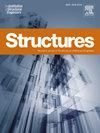基于实测数据和深度学习方法的既有桥梁结构有限元模型更新
IF 4.3
2区 工程技术
Q1 ENGINEERING, CIVIL
引用次数: 0
摘要
由于设计参数误差、施工误差和随时间变化的材料退化(如收缩和徐变)的影响,利用数值模拟直接预测既有混凝土梁桥结构的承载力具有挑战性。针对这一问题,提出了一种基于代理模型(PM)的有限元模型更新方法,并将其应用于实际板梁桥,与传统的承载力估算方法相比,提高了承载力估算的准确性。首先,考虑挠度和基频等对结构性能影响较大的关键力学参数,采用有限元法对某在役桥梁结构进行随机静载模拟。这产生了挠度和基频样本的大型数据集。在此基础上,利用深度神经网络构建了高精度的代理模型。此外,通过敏感性分析,确定了桥梁结构的关键力学参数,如边界约束刚度、混凝土抗压强度和钢筋弹性模量。然后利用这些参数对有限元模型进行了更新。通过现场实测数据验证了该方法的可靠性和准确性。修正模型的实测挠度与预测挠度的差值仅为0.4 %。在三种代理模型中,深度学习网络(DLN)在样本充足的情况下表现出最好的预测性能,而XGBoost在样本缺失的情况下表现出更好的预测效果。并利用改进后的有限元法对原桥的承载力进行了预测。结果表明,在实测数据有限的情况下,所提出的代理模型(PM)方法具有较高的承载力评估精度,为既有桥梁结构的安全评估和受损桥梁的剩余承载力评估提供了可靠的方法。本文章由计算机程序翻译,如有差异,请以英文原文为准。
Finite element model updating of existing bridge structures based on measured data and deep learning method
Due to the influence of design parameter errors, construction inaccuracies, and time-dependent material degradation, such as shrinkage and creep, it is challenging to directly predict the bearing capacity of existing concrete girder bridge structures using numerical simulations. To address this issue, a finite element model (FEM) updating method based on a proxy model (PM) is proposed and applied to a real-life plate girder bridge, aiming to enhance the accuracy of bearing capacity evaluation compared to traditional estimation methods. Firstly, considering the critical mechanical parameters that significantly influence structural performance, such as deflection and fundamental frequency, a bridge structure in service was simulated using the FEM and subjected to random static vehicle loads. This generated a large dataset of deflection and fundamental frequency samples. Based on these samples, a high-precision proxy model (PM) was constructed using a deep neural network. Additionally, through sensitivity analysis, key mechanical parameters of the bridge structure—such as boundary restraint stiffness, compressive strength of concrete, and elastic modulus of reinforcement—were determined. The finite element model was then updated using these parameters. The reliability and accuracy of the proposed method were validated against in-situ measured data. The difference between the measured deflection and the predicted deflection of the updated model was only 0.4 %. Among three proxy models, the deep learning network (DLN) showed the best prediction performance with sufficient samples, while XGBoost proved more effective in cases with missing samples. Furthermore, the updated FEM was used to predict the bearing capacity of the original bridge. The results demonstrated that the proposed proxy model (PM) method provided high accuracy in assessing the bearing capacity, offering a reliable approach for the safety evaluation of existing bridge structures and the residual bearing capacity assessment of damaged bridges, even with limited measured data.
求助全文
通过发布文献求助,成功后即可免费获取论文全文。
去求助
来源期刊

Structures
Engineering-Architecture
CiteScore
5.70
自引率
17.10%
发文量
1187
期刊介绍:
Structures aims to publish internationally-leading research across the full breadth of structural engineering. Papers for Structures are particularly welcome in which high-quality research will benefit from wide readership of academics and practitioners such that not only high citation rates but also tangible industrial-related pathways to impact are achieved.
 求助内容:
求助内容: 应助结果提醒方式:
应助结果提醒方式:


